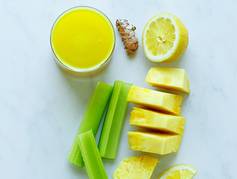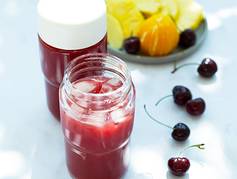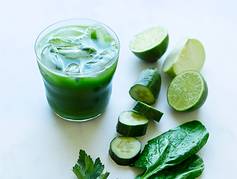Articles
Fuel Your Fitness Naturally with Juice
Fresh juices can be a game-changing addition to any athletic pursuit. These vibrant vegetable- and fruit-based drinks offer more than just hydration; they provide rapidly-absorbed carbohydrates, anti-inflammatory compounds, and performance-enhancing phytonutrients that can measurably impact your energy levels, endurance capacity, and post-exercise recovery.

Join us for a 5-day juice challenge designed to support your workouts from start to finish. Each day features a fresh juice recipe tailored to a different phase of exercise—from pre-workout energy and hydration to post-workout recovery. No powders, just whole fruits, vegetables, and performance-boosting ingredients to help you move, sweat, and recover naturally. Plus, by participating, you’ll have a chance to enter to win a Nama J2.

From weekend warriors to elite competitors, peak performance begins in the produce aisle. In fact, Los Angeles Laker LeBron James, the NBA’s all-time leading scorer, famously starts his morning with a green juice that fuels him until after practice. Let’s explore the science behind juicing and uncover combinations that can elevate your workout.
Juice is a natural sports drink While neon-colored commercial sports drinks promise electrolyte replacement, fresh juices deliver real nourishment in their natural form, along with a spectrum of vitamins, minerals, and bioactive compounds that synthetic drinks cannot match.
The key advantage? Nutrient density and bioavailability. When you juice fruits and vegetables, their cell walls break down, making nutrients more readily accessible to the body, which is a particular advantage for athletes and exercisers of all kinds who need quick fuel and efficient recovery.
You don’t have to be a competitive athlete to take advantage of fresh juice. These colorful drinks fuel everything from your morning walk or yoga practice to a weekend hike or long bike ride with friends.
Support different workout intensities Different levels of training require different levels of replenishment. Let’s first define what kind of movement you are engaging in.
LIGHT TO MODERATE MOVEMENT This type of exercise encompasses everything from walking and restorative yoga to chores around the house like making the bed or doing laundry. More moderate activity can include gardening, jogging, yoga flow, Pilates, a short HIIT (high-intensity interval training) workout, or lifting weights at the gym for about 30 minutes or so.
INTENSE MOVEMENT OR ENDURANCE TRAINING Intensive training is activity like running, swimming, biking, or high-intensity training that lasts 60 minutes or more. This type of movement also includes endurance training or any exercise that lasts for 45 to 60 minutes or more. With this training, you’ll want to replenish your body with electrolytes.

Ways to naturally fuel your workouts
Different levels of training require different levels of replenishment. Let’s first define what kind of movement you are engaging in.
PRE-WORKOUTKeep it simple. Focus on foods your body can break down quickly as heavier foods can cause cramping or discomfort. Pick a snack that’s low in fat, fiber, and protein, such as a banana, dates, other dried fruit, or an electrolyte-rich beverage like coconut water or fresh juice.
DURING EXERCISEIf exercising for 60 minutes or more or at a high intensity, you may need to refuel in the midst of your movement. Similar to pre-workout, fueling while exercising should be reserved for something extremely easy to digest like coconut water or an electrolyte-rich beverage, dates, and/or a banana. In most cases, people do not need to refuel while exercising.
POST-WORKOUTLook for fuel with both carbohydrates and protein, as muscle stores of carbohydrates need to be replenished and protein will help to repair small muscle tears and aid with restoration. Making a protein-rich smoothie, drinking a leafy green vegetable juice (dark green vegetables tend to be higher in protein than others) with or without extra plant-based protein, or even enjoying a meal that contains protein are all good options post-workout.
BALANCE THE GLYCEMIC LOADPure fruit juices can spike blood sugar, which is not ideal for long-lasting energy. Adding vegetables creates a more balanced profile. Aim for an 80/20 vegetable-to-fruit ratio for daily drinking to fuel a workout, and adjust to 50/50 for immediate pre-workout fuel.
CONSIDER DIGESTIONSome people need to dilute juices initially to avoid any GI distress, especially when consumed close to exercise.
EXTRA HYDRATIONMake sure you’re adding up to 20 ounces of extra fluid into your routine on days that you are active. If you are exercising in heat (such as hot yoga or in the summer heat), you may want to consider adding an extra 12- to 16-ounce portion of an electrolyte-rich beverage like coconut water or a juice regardless of the amount of time you exercise. That’s because of sweating and the need to replace electrolytes.

What are electrolytes?
Electrolytes are important nutrients for the body, as they play key roles in sending electrical impulses that influence our heart, muscles, and nerves. They also help balance fluid and hydration in your cells, tissues, and muscles. Lack of sufficient electrolytes can contribute to muscle cramps, delayed muscle soreness and spasms following exercise, and can contribute to headaches for some people. Electrolytes are minerals such as sodium, potassium, calcium, chloride, and magnesium. Most often, they can be found in foods but they can also be found in beverages like juices and coconut water.
Foods that are naturally higher in electrolytes include all plant-based foods, but particularly fruits and vegetables, and primarily those that are red, orange, and/or yellow. These fruits and vegetables not only contain a rich source of potassium but are good sources of magnesium. Green leafy vegetables can also be a good source of calcium and potassium. Vegetables that are naturally high in sodium include celery, beets, bok choy, and bell peppers.
Boost performance
A small 2025 study looked at the utility of caffeine and beet juice as performance enhancers. We already know beet juice is a great source of dietary nitrates and can enhance performance by increasing nitric oxide levels, which helps improve blood flow and mitochondrial function. Researchers found that study participants who consumed both caffeine and beet juice performed significantly better in a 1,000-meter running competition than those who consumed a placebo capsule and drink. So don’t be afraid to pair your morning coffee or matcha with a beet juice before heading to the gym.
Juicing enhances nutrient absorption, as it helps the body quickly absorb essential nutrients and minerals. Here’s a combo that exercise enthusiasts need to try: citrus and leafy greens. The vitamin C in citrus fruits can enhance non-heme iron absorption significantly. Pairing vitamin C-rich citrus fruits with iron-containing foods can optimize your nutrient intake. For example, adding oranges or lemons to a juice with spinach helps make the iron more bioavailable to the body. Plus, it tastes good. Spinach works to increase muscle strength, improve endurance, and prevent premature fatigue during running sessions or other cardio workouts.

Accelerated recovery
Post-workout is where juicing can shine. A well-crafted recovery juice delivers what depleted muscles need in a form they can utilize. Endurance athletes can incorporate recovery juice featuring specific ingredients. Try a juice with pineapple, tart cherries, turmeric root, and a touch of black pepper. Tart cherries contain high levels of anthocyanins that combat exercise-induced inflammation, while bromelain in pineapple helps reduce swelling and accelerate tissue repair. The curcumin in turmeric, enhanced by the piperine in black pepper, further amplifies the anti-inflammatory effects.
Before diving into specific fruits and vegetables that can be great for exercise, one new study debunks a long-held belief that making gains in the gym requires eating animal protein. New data from a small trial found that both vegan and omnivore diets offer similar “muscle-building potential.” This research confirms that plants are an excellent way to fuel your body before or after a workout.

Antioxidants to the rescue
A regular, moderate exercise routine is associated with higher natural antioxidant levels and decreased damage caused by oxidative stress. But more intense workouts or training more regularly also contributes to stress on the body, which can lead to muscle fatigue, reduced endurance, and delayed recovery. Eating foods high in antioxidants known as anthocyanins, including fruits like blueberries, tart cherries, and pomegranates, can help reduce oxidative stress and inflammation after you exercise, according to this study.
Another review looked at tart cherry and pomegranate juice supplementation and concluded that higher total doses of phenolic compounds and longer supplementation durations (beginning several days before strenuous exercise, and continuing through the recovery period) are more likely to have a positive effect. Pay attention to whether you notice a difference with the consistent addition of anthocyanin-rich fruits or juices and blends before or after your workouts.
For workouts & strong bones
If there’s one green vegetable to add to your juices that can be beneficial for workouts and more energy in general, it’s kale. This leafy green comes in many forms from curly to lacinato to Red Russian varieties. Kale provides a plethora of key vitamins and minerals to protect against free radicals and boost your energy levels.
KALE CONTAINS: Vitamin C, Vitamin B6, Vitamin A, Vitamin K, Calcium, Potassium, Iron, Magnesium
Vitamin K is essential for maintaining strong, healthy bones and plays a role in the body's ability to utilize calcium, preventing bone loss and reducing the risk of fractures. Adequate vitamin K intake has been linked to improved bone density. Moreover, kale also provides calcium, an essential mineral for maintaining bone health and preventing age-related bone deterioration.
A versatile energy source
The humble carrot is a nutritional powerhouse for athletes and exercisers alike. It’s high in vitamins A, K, biotin, potassium, and antioxidants like beta-carotene and flavonoids. This root vegetable easily pairs with other highly nutritious ingredients like apples, ginger, or oranges to make juices that can fuel your activity and offer steady energy. It can also stand on its own. Drinking carrot juice helps protect the cardiovascular system by increasing total antioxidant status, according to this study.

Relieve muscle soreness
Watermelon is a great summer treat, as it’s both hydrating and sweet, but it also helps reduce post-training muscle soreness. That’s because watermelons contain the amino acid, L-citrulline, which according to one study helps relieve muscle aches. The study found cyclists who consumed 17 ounces of fresh watermelon juice one hour prior to an intense interval regime had less post-training soreness. In addition, one cup of watermelon contains 170 milligrams of potassium, an essential mineral that supports nerve and muscle function, and the fluid balance in your body.

Community Spotlight
Jen Hansard
@simplegreeensmoothies
Jen is a long-distance trail runner, mom of two teens, smoothie lover, plant-based foodie, and Air Force chaplain’s wife. What began as a green smoothie habit turned into a mission to help others eat more plants and fuel their passions. She lives in Oklahoma with her family of outdoor adventurers. She loves helping others make healthy living fun and doable.
Q: How do juices and smoothies fit into your personal fitness and running routine? Do you have an approach for fueling longer runs or intense workouts?
Jen: As a 42-year-old mom who loves trail running and keeping up with my teens, smoothies and juices are my not-so-secret weapon. For shorter runs or quick workouts, I go for a fresh juice—something light and hydrating like beet, carrot, or green juice. It’s like liquid sunshine.
When I’m gearing up for a long trail day, then it’s smoothie time. I build mine to give me steady energy. Think fruit, spinach, oats, and chia seeds. It’s light but keeps me going strong for hours. After a big run, I’m all about recovery. That’s when I make a smoothie with plant-based protein using hemp hearts, a scoop of protein powder, or my own homemade blend with hemp, flax, and chia. It helps my muscles bounce back so I can still run errands and make dinner. I just tune in to what my body needs: quick hydration, slow fuel, or muscle repair. Smoothies and juices make it all feel doable.
Q: In June, you completed your fifth Rim-to-Rim-to-Rim in the Grand Canyon, which covers more than 40 miles and gains more than 11,000 feet in elevation. How did you prepare for this adventure? What plant-based sources do you rely on to stay hydrated?
Jen: I am wildly in love with the Grand Canyon’s inner corridor. It’s rugged, remote, and absolutely magical. Every time I step onto South Kaibab Trail, I get a mix of excitement and nerves because no matter how much I train, the Canyon always finds a way to humble me... and teach me something.
To prep for my fifth R3 (yep, I’m hooked), I did a lot of incline treadmill hikes and bleacher runs with my hydration pack strapped on. I also fit in longer trail runs (8 to 13 miles) to get used to being on my feet for 6+ hours, which helps avoid blisters in the canyon.
During the adventure, I drank tons of water and used Skratch electrolytes (made with real fruit. Yes, please). My fuel lineup was really glamorous: dried mango, Gushers (don’t judge), dates, pretzels, and MammaChia pouches. I need snacks that keep me smiling and steady.
Q: You focus on “simple” recipes. Why is simplicity so important when it comes to healthy eating?
Jen: Healthy eating can get complicated real fast. One week you’re all in on spirulina powder, the next week it’s buried behind your half-used jar of cashew butter and you’re Googling, “Is this still good?”
I’ve learned that the simpler I keep things such as real, whole foods close to the way nature made them, the easier it is to stay consistent. My recipes are built on fruits, veggies, nuts, and seeds. I love giving people a starting point they can actually use and then customize. Want to add protein powder? Do it. Craving crispy tofu? Toss it on. The goal is to build consistent healthy habits, not overwhelm your kitchen.
Q: What’s your focus when it comes to pre-workout vs. post-workout nutrition, particularly with juices and smoothies?
Jen: Before a workout, I focus on hydration and a little natural sugar to get me going like juice, smoothie, or a chia fresca. I almost always have a cup of coffee too, because I like the boost.
After a workout, I know I need protein for recovery, but my heart usually just wants a giant bowl of watermelon. So, I do both: protein shake first like a responsible adult, then watermelon party. Best of both worlds.
Q: Name your top 3 ingredients that should be in everyone’s smoothie cabinet.
Jen: I’ve been blending for 13 years, and these three always make the cut:
Frozen pineapple – Adds natural sweetness and masks any bitter greens.
Chia seeds – Tiny but mighty: fiber, protein, omega-3s, and totally neutral in taste.
Costco power greens – A mix of spinach, chard, and kale that lets me sneak in a variety of leafy greens without thinking too hard.
Q: What’s your go-to green smoothie recipe that never fails?
Jen: I love, love, love the Best Green Smoothie recipe. It’s the OG recipe that started my blog! It’s been a fan favorite since 2012 and still one of my ride-or-dies.
Here’s how it goes:
1 cup spinach
1 cup water
½ cup frozen pineapple
½ cup frozen mango
1 banana
I blend it all together until smooth and creamy.
If I want to make it extra healthy, I’ll swap in 2 cups of power greens (double up, baby!), use half a banana or ¼ avocado, and add some chia seeds. It’s tropical, nutrient-packed, and seriously good. My whole family drinks it.

Community Spotlight
Brett Canady
@juicefeaster
Brett is a lifelong juicing advocate who has personally transformed and maintained his health using the magical powers of juicing and raw living foods.
Q: What are your workout routines like? How much time do you spend running or at the gym per week?
Brett: I try to do some type of fitness at least six days a week with one day as an active recovery/rest day. When I’m training for a marathon, I run four to five days each week. Most of them are in Zone 2 or at a lower heart rate with at least one day of speed or track running. My runs are usually in the 45- to 90-minute range when doing Zone 2 training. I also have at least one longer run per week that can range from 6 miles up to 20 miles before tapering off a couple of weeks prior to the actual marathon.
When not intensively training for a marathon, I run a little less but add in days where I do some strength training with kettlebells or calisthenics, ride my bike, or hit the rowing machine in the gym for cross training.
Q: Tell us about your marathon journey. How often do you run them? How do they make you feel? How do juice, smoothies, or milk play a role in your training?
Brett: I ran my first full marathon back in 2013 and swore I’d never run another one ever again! Haha! But I got the itch again in 2019 and have run at least one full marathon every year since with the exceptions of 2020 and 2021 since none were held during the pandemic. So, I’ve run six full marathons in total.
I started running half marathons in 2009 and have run at least one a year every year since, even during the pandemic. I found some “virtual” half marathons to sign up for in 2020 and 2021.
Honestly, running them makes me feel amazing! I love putting them on the calendar and having a goal to work toward. All of the early morning runs and preparation are so worth it to me. Crossing the finish line is just the icing on the cake.
Juices, smoothies, and plant milks play a huge role in my nutrition. I usually have 16 to 32 ounces of juice prior to a run. Then, either a 32-ounce juice or smoothie is the post run refuel of choice for me. I tend to enjoy an 8 to 10 ounce serving of nut or seed milk later in the day.
Q: Can you share a favorite juice recipe that helps you fuel up before or after an exercise (run) session?
Brett: I absolutely love fresh OJ or fresh pineapple juice before a run! 16 to 32 ounces of either is a staple prior to heading out. It's simple, easy to digest, and a great way to top off the tank before the run or workout.
Post workout, my absolute favorite recovery juice is watermelon, beet, celery, and lime. It's an electrolyte powerhouse to replenish with. It also has a ton of phytonutrients that dilate blood vessels as well as increase oxygen uptake and support muscle recovery. About 32 ounces of this combo, and I’m set for a great recovery post workout.
Q: Are there any secret ingredients (fruits or vegetables) that really help you to recover from a workout or give you energy when you are feeling a bit of a crash?
Brett: My trifecta of secret ingredients that every active person should have in their arsenal are beets, watermelon, and pomegranates. I can usually find amazing beets year-round and then rotate between pomegranates and watermelon seasonally. All three of these are absolutely incredible for their anti-inflammatory, oxygen uptake, and blood flow support as well as muscle recovery benefits.
Q: As someone with a busy and active lifestyle, what are your favorite sources of plant-based protein? Do you rely on any milks, juices or smoothies for protein?
Brett: I don’t worry about protein too much. In my experience, the lower protein and fat that I consume the better my VO2 Max is and the better my overall performances are. We don’t need protein, we need amino acids, all of which are easily found in plants. I grow a ton of fresh sprouts, which end up in my juices, smoothies, and salads. They are probably my biggest source of essential amino acids.
The great benefit of juicing is that I can acquire the nutrition of way more plants than I could ever consume if eating them solely as solid food. This includes amino acids. And in juice format, all of this nutrition is easier to absorb, with the highest bioavailability and the lowest amount of metabolic stress.
Honestly, I juice, I make smoothies, I eat solid plant foods. To me, all of these are mutually beneficial, not mutually exclusive.
Q: How about hydration: do you have a go-to drink that helps you feel hydrated after exercising outside or on a hot day?
Brett: Another one of my go-to hydration juices after a workout or on a hot day is cucumber, watermelon, mint, and lime. Sometimes, I even sprinkle in a pinch of sea salt as well. So refreshing and so hydrating!
- Choosing a selection results in a full page refresh.
- Press the space key then arrow keys to make a selection.




